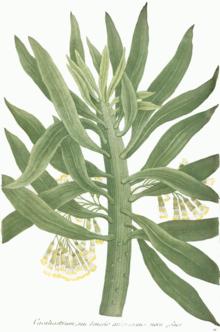| Senecio arborescens | |
|---|---|
 | |
| Illustration[1] | |
| Scientific classification | |
| Kingdom: | Plantae |
| Clade: | Tracheophytes |
| Clade: | Angiosperms |
| Clade: | Eudicots |
| Clade: | Asterids |
| Order: | Asterales |
| Family: | Asteraceae |
| Genus: | Senecio |
| Species: | S. arborescens |
| Binomial name | |
| Senecio arborescens | |
| Synonyms[3] | |
| Baccharis halimifolia L. | |
Senecio arborescens is a flowering plant in the aster family, but the available information about it is mostly conflicting and old.
According to the World Conservation Union, S. arborescens is a native to and widely occurring in the area ranging from Mexico to possibly Colombia.[2] John Claudius Loudon says that S. arborescens is a synonym for Baccharis halimifolia and native of the United States from "Maryland to Florida, on the sea coast" in his 1842 catalog of trees and shrubs[3] and Raymond Taylor agrees with this in his 1952 catalog of Plants of Colonial Days, which also claims that the plant is native to New Jersey and was introduced to Collinson in England from John Bartram in Cape May in 1683.[4] And a group of botanists under the discipline of Hieronymum Lentzium seem to have attempted to record the species as a Cacalia when they drew a nice image of a completely different plant for their 1737-1745 catalog.[1]
It is considered a synonym of Telanthophora grandifolia in Plants of the World Online.[5]
References
- ^ a b Weinmann, Johann Wilhelm; Dieterichs, Johann Georg Nicolaus; Bieler, Ambrosius Karl; Seuter, Bartholomeo; Ridinger, Johann Elias; Haid, Johann Jacob; Heinrich Georg Neubauer; Hieronymum Lentz (1737–1745). Phytanthoza iconographia, sive, Conspectus aliquot millium : tam indigenarum quam exoticarum, ex quatuor mundi partibus longâ annorum serie indefesoque studio (4th ed.). Sumptibus imprimebatur Ratisbonae [Regensburg] : Per Hieronymum Lentzium. QK41 .W46 1737 -45 [#914- 917].
- ^ a b Mitré, M. (1998). "Senecio arborescens". IUCN Red List of Threatened Species. 1998: e.T37803A10077215. doi:10.2305/IUCN.UK.1998.RLTS.T37803A10077215.en.
- ^ a b Loudon, John Claudius (1842). "XLII Compo'sitae: Ba'ccharis". TREES AND SHRUBS; BEING THE ARBORETUM ET FRUTICETUM BRITANNICUM ABRIDGED: CONTAINING THE HARDY TREES AND SHRUBS OF BRITAIN NATIVE AND FOREIGN, SCIENTIFICALLY AND POPULARLY DESCRIBED; WITH THEIR PROPAGATION, CULTURE, AND USES IN THE ARTS; AND WITH ENGRAVINGS OF NEARLY ALL THE SPECIES. Printed for the author and sold by Longman, Brown, Green, and Longmans. pp. 1196 pages. Retrieved 2008-04-08.
- ^ Taylor, Raymond L. (1997) [1952]. "Section 2". Plants of Colonial Days. Courier Dover Publications. pp. 112 pages. ISBN 0-486-29404-8. Retrieved 2008-04-08.
- ^ "Senecio arborescens Steetz". Plants of the World Online. Royal Botanical Gardens Kew. Retrieved 13 December 2018.
External links
- Seemann, Berthold Carl (1854). Botany of the Voyage of H.M.S. Herald, under the Command of Captain Henry Kellett, R.N., C.B., during the years 1845-1851. p. 162. QK5.S44.
